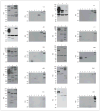Melanoma-associated retinopathy: a paraneoplastic autoimmune complication
- PMID: 20008709
- PMCID: PMC4618318
- DOI: 10.1001/archophthalmol.2009.311
Melanoma-associated retinopathy: a paraneoplastic autoimmune complication
Abstract
Objectives: To study 11 patients with melanoma-associated retinopathy (MAR) to clarify the reliability of various methods of diagnostic testing, to determine the underlying antigenic retinal proteins, and to study the clinical histories and types of associated melanomas.
Methods: Clinical data were obtained from patients with melanoma who developed marked visual problems. Testing included electroretinography, kinetic visual fields, comparative studies of Western blots, and indirect immunohistologic examination to detect antiretinal antibodies, as well as proteomic studies to identify underlying antigenic retinal proteins.
Results: Patients with MAR typically have rapid onset of photopsias, scotomata, and loss of central or paracentral vision. Ophthalmoscopy seldom shows significant changes early, but electroretinograms are abnormal. Results of Western blots and immunohistologic examination can show antiretinal antibodies but not always. Most patients (9 of 11) had a strong family history of autoimmune disorders. Any type of melanoma (cutaneous, choroidal, ciliary body, or choroidal nevi) may be associated with this paraneoplastic autoimmune reactivity. MAR may precede or follow the diagnosis of melanoma. Patients with MAR have the same antigenic retinal proteins that have been associated with cancer-associated retinopathy. In addition, 2 new antigenic retinal proteins, aldolase A and aldolase C, were found.
Conclusions: There was a high prevalence of positive family histories of autoimmune disease in patients with MAR. To confirm the disorder, multiple clinical and serum diagnostic techniques (Western blot or indirect immunohistologic examination) are needed. Two newly observed antigenic retinal proteins, aldolase A and aldolase C, are associated with MAR.
Figures



References
-
- Sawyer RA, Selhorst JB, Zimmerman LE, Hoyt WF. Blindness caused by photoreceptor degeneration as a remote effect of cancer. Am J Ophthalmol. 1976;81(5):606–613. - PubMed
-
- Suhler EB, Chan CC, Caruso RC, et al. Presumed teratoma-associated paraneoplastic retinopathy. Arch Ophthalmol. 2003;121(1):133–137. - PubMed
-
- Saito W, Kase S, Ohguro H, Furudate N, Ohno S. Slowly progressive cancer-associated retinopathy. Arch Ophthalmol. 2007;125(10):1431–1433. - PubMed
-
- Gass J. Acute Vogt-Koyanagi-Harada-like syndrome occurring in a patient with metastatic cutaneous melanoma. In: Saari K, editor. Uveitis Update: Proceedings of the First International Symposium on Uveitis. Amsterdam, the Netherlands: Elsevier Science; 1984. pp. 407–408.
-
- Keltner JL, Thirkill CE, Yip PT. Clinical and immunologic characteristics of melanoma-associated retinopathy syndrome: eleven new cases and a review of 51 previously published cases. J Neuroophthalmol. 2001;21(3):173–187. - PubMed
Publication types
MeSH terms
Substances
Grants and funding
LinkOut - more resources
Full Text Sources
Medical

